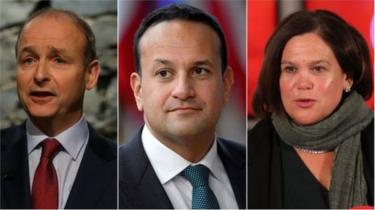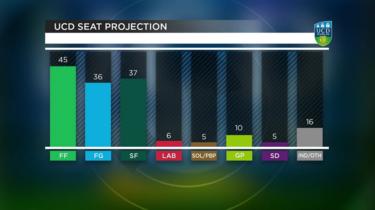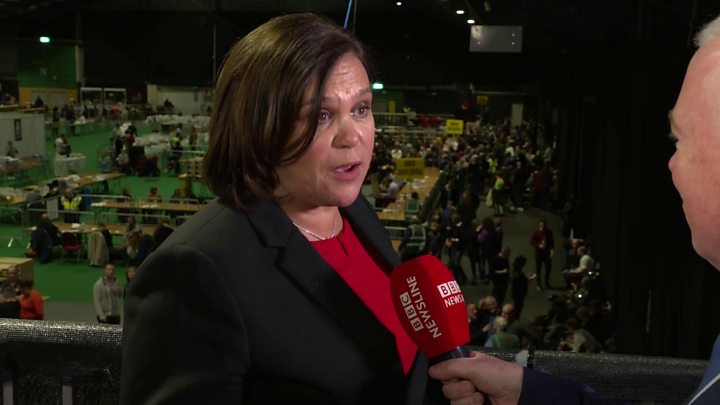Europe
Before the election, both Fine Gael and Fianna Fáil ruled out forming a government with Sinn Féin, citing its tax policies and IRA past as deterrents.
On Sunday evening, taoiseach (Irish PM) and Fine Gael leader Leo Varadkar said it would be "challenging" to form a government.

Fianna Fáil leader Micheál Martin did not rule out working with Sinn Féin, but said "significant incompatibilities" still existed.
Sinn Féin leader Mary Lou McDonald said she was exploring options to see if it would be possible to form a government without either Fine Gael or Fianna Fáil.
- Election marks seismic break for two-party system
- Follow live updates
- Profile of Ireland's political parties
'Two-party system is gone'
Speaking to RTÉ's Morning Ireland programme on Monday, Ms McDonald said there was "no doubt the politics of the two-party system is now gone and over".
"This vote for Sinn Féin is for Sinn Féin to be in government… for Sinn Féin to deliver," she said.
"My first job of work, and I commenced this yesterday, is to establish with other parties whether or not there are the numbers to deliver a government without Fianna Fáil or Fine Gael."
Also speaking on the programme, outgoing Irish finance minister and Fine Gael TD Paschal Donohoe said it was likely "some form of engagement will happen" with Sinn Féin, but that the two parties would not be going into government together.
He added the Sinn Féin result was a "remarkable achievement".

'Result marks seismic break for two-party system'
By Chris Page, BBC News Ireland Correspondent
"Seismic", "historic", "momentous" - those are the sorts of words which are being used to describe the results in the Irish general election.
Of course, those superlatives are being spoken by Sinn Féin politicians and activists to describe their party's surge.
But they are also coming from the lips and pens of political analysts, as they assess how Mary Lou McDonald's party has loosened the decades-long grip of the two parties which have dominated Irish governments.
Sinn Féin's margin of victory in the first preference vote was in line with its best performances in opinion polls during the campaign with 24.5% of voters placing a '1' next to a Sinn Féin candidate.
Fianna Fáil - led by the former Foreign Minister Micheál Martin - received 22.2% of the first preferences. Fine Gael - whose leader is the current Taoiseach Leo Varadkar - polled 20.9%.
Sinn Féin ran fewer candidates than its rivals, meaning its pole position in the first stage of the count is unlikely to translate into it being the largest party in the main house of the Irish parliament, the Dáil.
Read more from Chris Page here.

DUP leader Arlene Foster said younger voters had backed Sinn Féin as a "protest vote".
Mrs Foster's party are in a powering sharing government with Sinn Féin in Northern Ireland.
Speaking on BBC Radio Ulster's Good Morning Ulster programme she said: "I think from a Northern Ireland perspective we will have to work with whoever the government is in the Republic of Ireland. We will have our own policy here."
Mrs Foster also questioned whether Sinn Féin would have their focus on Northern Ireland questioned, in the way there had been a "wailing and gnashing of teeth" over her party's confidence-and-supply agreement with the previous Conservative government in the UK.
Rise in seats
Following the last election in 2016 Sinn Féin had 23 seats in the Dáil (Irish parliament).
There are 160 seats up for election this time around, and Sinn Féin is set to dramatically increase how many it holds after it won the most first preference votes.
Ms McDonald said this election was about "change".
She topped the poll in her four-seat Dublin Central constituency.
"The frustration people have felt for a long time with the two-party system, whereby Fine Gael and Fianna Fáil handed the baton of power between each other - that's now over," she said.
 UCD/ RTÉ
UCD/ RTÉ
Fine Gael has been in government since 2011, firstly with the Labour Party and then with independents and with a confidence and supply deal with Fianna Fáil.
It looks set to lose seats for the second election in a row, but that does not necessarily rule it out of forming another government.
Its share of first preference votes dropped from 25.5% at the last election to 20.9%.

The taoiseach said he was "not really" disappointed that he did not top the poll in his own constituency. He did get an increase in his votes compared to the last election.
He added it was now clear there was now a "three-party system".
Earlier on Sunday Micheál Martin said reports suggested his party "would be the largest" but that it was early days.
He said the most important thing when forming a government was "compatibility in the programme for government" and that formation of a government was going to be very difficult.
Mr Martin added he was a "democrat" and respected the will of the people.
What about the smaller parties?
The Green Party is also set to increase the number of seats it holds.
Green leader Eamon Ryan, who was elected on the first count for Dublin Bay South, said his party would play its part in talks to form a government.
The Green Party secured 7.1% of first preference votes, followed by Labour (4.4%), Social Democrats (2.9%), Solidarity-People Before Profit (2.6%).
Aontú (1.9%) independents (12.2%) and others (1.3%) accounted for the rest.
Bbc







0 Comments